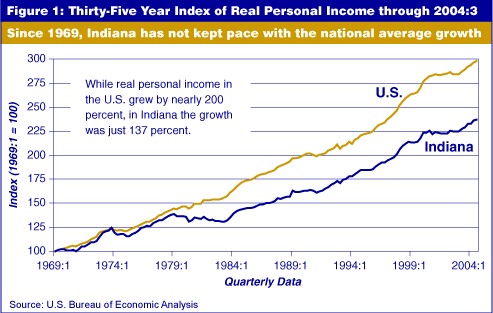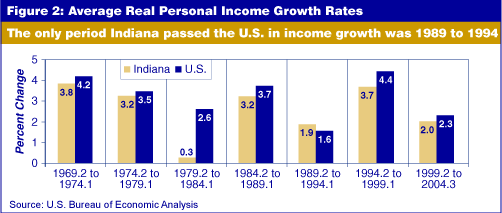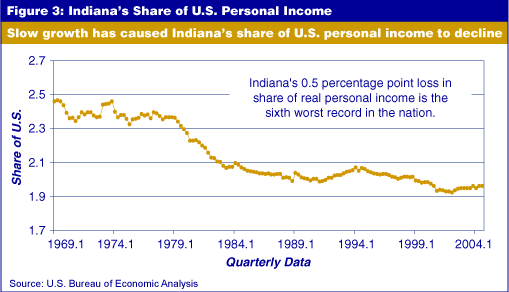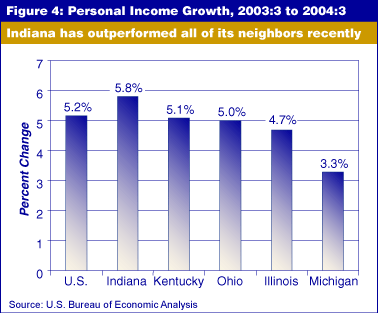The Long and Short of Indiana's Economy
It is easy to recline comfortably on a winter day in Indiana and reflect on all that is good. Business for many has been just fine over the past few years so that we forget the essential truth of Indiana’s economy.
Yet there are ongoing pressures on state and local government revenues while the demand for the services of governments rise. Although business in some parts of the Indianapolis area looks good, it is far from healthy elsewhere. How can things be so good and so bad at the same time?
Let’s sit back and look at the record of the past 35 years. Our measure of economic performance is the most basic data: real personal income, that is, the total money the people of Indiana make as a result of working for themselves or someone else, plus all the dividends, interest and rent they collect, plus any Social Security, unemployment compensation or other payments from the federal government. When we say real, we mean adjusted for price changes to year 2000 levels.
Figure 1 compares Indiana’s record of growth in real personal income with that of the nation. Both economies are set equal to 100 in the first quarter of 1969 and then the chart follows them through 143 quarters to the third quarter of 2004.

Indiana kept pace with the U.S. economy until 1979 and then began to slip. The gap between the two grew. By the third quarter of 2004, the latest data we have, the nation had grown by nearly 200 percent from 1969, but Indiana had advanced by only 137 percent. What does this mean in dollars? In the third quarter of 2004, the citizens of Indiana had real personal income of $175.4 billion, which was $44.8 billion (20 percent) below what they would have had if they had kept pace with the nation over the past 35 years. What would it mean to your business if the market was 20 percent larger?
The disparity between Indiana and the nation is very strong. When Indiana is ahead of the nation, the average growth differential is 2 percent, and when Indiana lags the nation, the average is -2.3 percent. But Indiana’s economy has grown faster than the nation in only 57 of the past 142 quarters, just 40 percent of the time. The result is shown in Figure 2, where Indiana has led the nation in only one of the five-year periods shown.

The only period when Indiana led the nation was between 1989 and 1994, the slowest five-year growth period since 1969. The result of Indiana’s slower growth rates has been a declining share of U.S. personal income (see Figure 3).

At the start of 1969, Indiana ranked as the 11th largest economy in the United States. By the third quarter of 2004, Indiana ranked 16th in the nation, passed by Georgia, Maryland, North Carolina, Virginia and Washington (see sidebar). The state’s share of the nation’s personal income slipped from 2.5 percent to 2 percent. This drop was the sixth worst record in the country.
How Are We Doing Now?
Many will respond that all this is old news and that we must concentrate on how we are doing now. What is now? The latest information we have is the third quarter of 2004. Is “now” our performance over the past year? That is, from the third quarter of 2003 to the same time in 2004? Let’s look at that record.
Over the past year, the Indiana economy has outperformed the United States in personal income gains. Indiana grew by 5.8 percent compared to a 5.2 percent increase nationally, the 15th best record in the country and better than all of our neighboring states, as seen in Figure 4.

What’s driving Indiana’s good performance in this period? The easy, but incorrect, answer would be farming. In the year 2003–2004, farm earnings rose by 24.4 percent in Indiana, but this is a small, highly volatile sector that contributed only 0.5 percent of total personal income in the third quarter of 2004. Of the total increase in personal income for the state, farming contributed just 2 percent, nearly four times its share.
The driving force in the economy for the past year was durable goods manufacturing, which contributed 21 percent of the growth Indiana experienced. Another 10 percent of the growth came from nondurable goods. Thus, nearly a third of Indiana’s growth came from the depressed sectors that were in recovery. This suggests that Indiana’s economy is not changing, but is replicating its previous structure. This is not necessarily bad, despite the often heard cries for restructuring. There may be real changes taking place within manufacturing that make this a continuing healthy sector for the state.
Economic development efforts involve subtlety. It is not a case of rejecting the past and its structure as much as determining what is and is not working to increase income in the state. Diversification for its own sake is not a reasonable objective. Higher income, not restructuring Indiana’s economy, is the goal.
The issue is that Indiana has failed to keep pace with the nation year after year. To break that cycle, the state has embarked on a series of important initiatives. It will take years to see if these are successful. We should not be diverted from continuing these efforts by the results of a single year in which we enjoyed some marginal improvements in personal income.
Morton J. Marcus
Director Emeritus, Indiana Business Research Center,
Kelley School of Business, Indiana University
